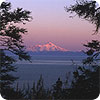For the more information about the air resources of the National Park Service, please visit http://www.nature.nps.gov/air/.








National Natural Landmarks Program
"Encourage and support the voluntary conservation of sites that illustrate the nation's geological and biological history, and to strengthen the public's appreciation of America's natural heritage."

National Natural Landmarks Program
The National Natural Landmarks (NNL) Program recognizes and encourages the conservation of sites that contain outstanding biological and geological resources, regardless of landownership type. It is the only natural areas program of national scope that recognizes the best examples of biological and geological features in both public and private ownership. NNLs are owned by a variety of land stewards, and participation in the program is voluntary.
National Natural Landmarks are selected for their outstanding condition, illustrative value, rarity, diversity, and value to science and education. Sites are designated by the Secretary of the Interior, with landowner concurrence, and to-date, nearly 600 landmarks have received the NNL designation within the United States, American Samoa, Guam, Puerto Rico, and the U.S. Virgin Islands.
The National Park Service administers the program, reports on the condition of the NNLs, acts as an advocate for the protection of designated sites, and raises public awareness of our Nation's natural heritage. Ongoing partnerships with public and private landmark owners allow participants to share information, solve problems cooperatively, and conserve outstanding sites that illustrate the rich and diverse tapestry of the country's natural landscape.
For further information about how the National Park Service's National Natural Landmarks Program is is serving its mission, be sure to read our program brochure (PDF - 1.76MB) and annual report (PDF - 3.71MB).
National Natural Landmarks Program Features
Photo Contest

The NNL Program is proud to host an annual NNL Photo Contest to help raise
public awareness of the program and the great diversity of natural features
at NNL sites across the country. Winning photographs are beautifully
showcased in a wall calendar produced and distributed for the year following
each contest. For more information regarding contest dates, entry rules,
and to see past winners, please visit our photo contest page.
Learn more...
Annual Report

The NNL Program produces an annual report to provide an overview of the program for the past year and includes details about completed and continuing projects. Read the reports to learn more about new landmark designations, events, site visits, technical support, and conditions at National Natural Landmarks over time. Learn more...
Frequently Asked Questions

What makes a National Natural Landmark significant? Why are they important? How many are there? Are they open to the public? Find out the answer to these questions and many more by visiting this collection of frequently asked questions. Learn more...
National Natural Landmarks Directory

Some sites designated as NNLs are well known, such as the volcanic crater Diamond Head on the Island of Oahu, Hawaii, the Okefenokee Swamp in Georgia, or the Rancho La Brea tar pits in Los Angeles, California; however, you might be surprised to discover what other sites share the NNL designation. Find NNLs by state using this National Natural Landmarks map directory. Learn more...
Useful Resources
- National Registry of Natural Landmarks (PDF - 570KB)
- National Natural Landmarks Program Brochure (PDF - 1.76MB)
- National Natural Landmarks Regulations (PDF - 120KB)
- National Natural Landmarks Briefing Statement (PDF - 352KB)
Last Updated: May 04, 2011





